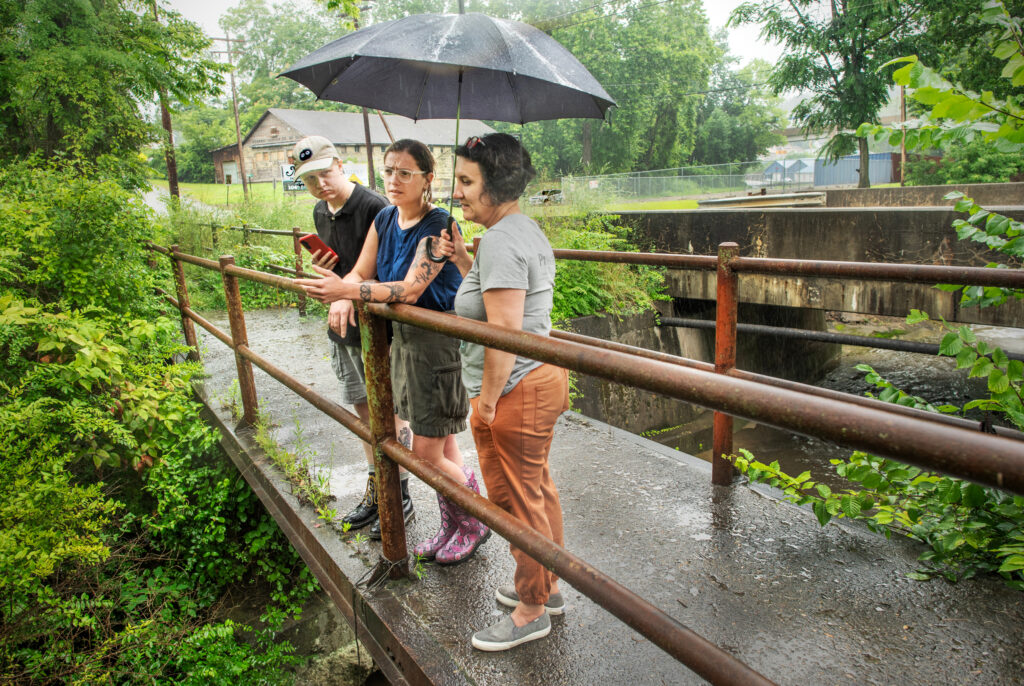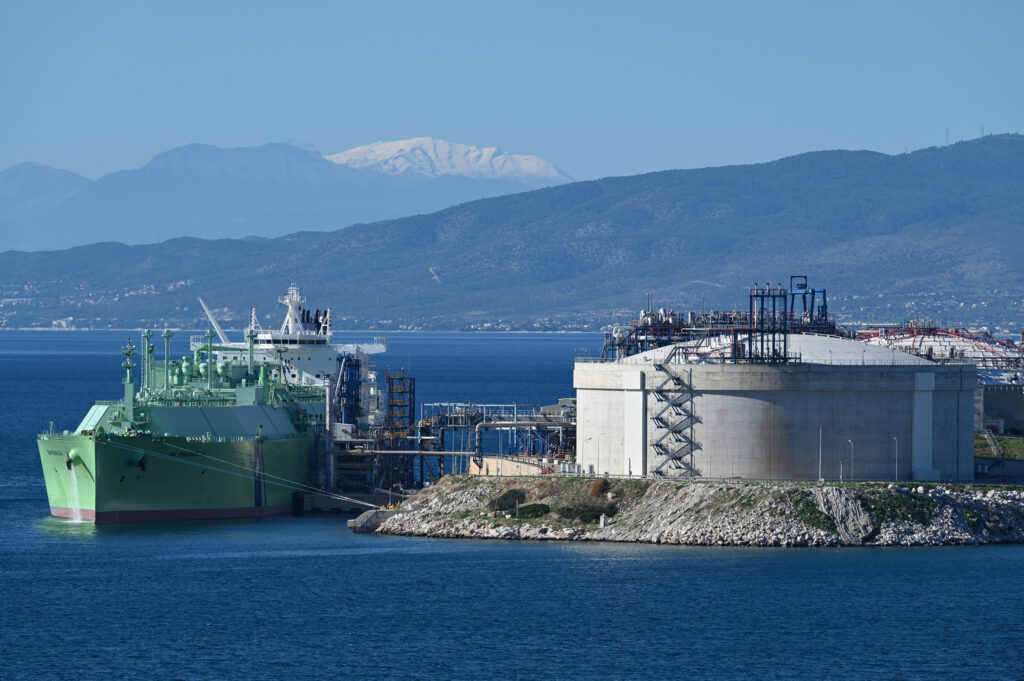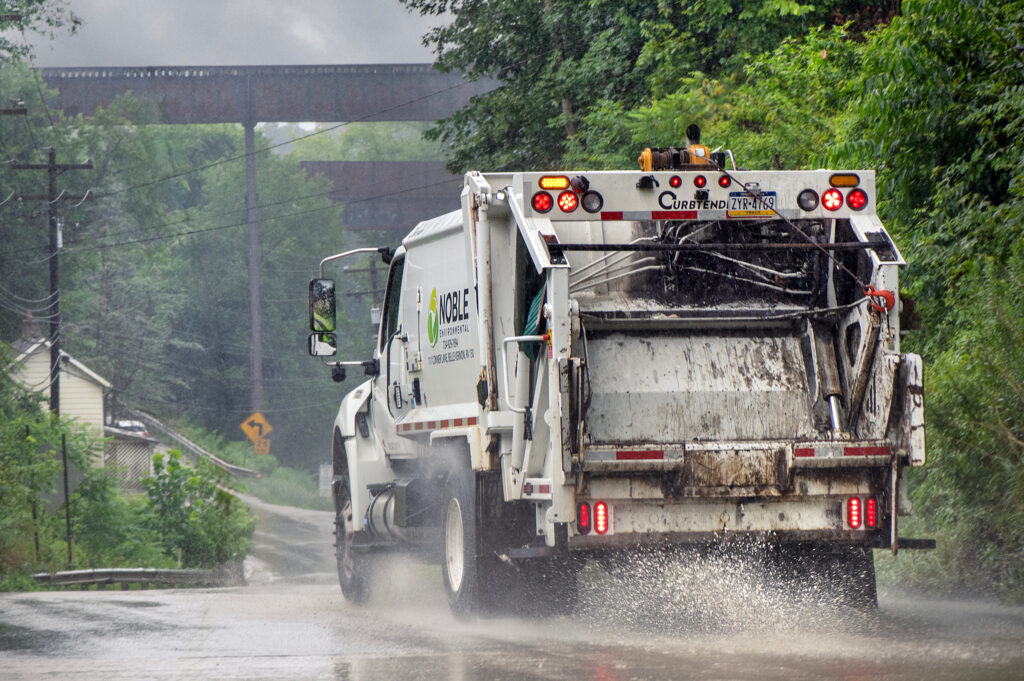Marine biologist Kirsten Young set sail in July for the Norwegian Sea aboard a 74-foot sailboat named Witness. She was joined by 11 other researchers and campaigners from the environmental activist group Greenpeace to conduct a scientific survey of marine mammals in waters Norway has designated for deep sea mining.
For the next two weeks, crew members took turns searching for whale spout blows, flukes and dorsal fins piercing through gray fog. Sometimes the fog was so thick they couldn’t see anything, but they could hear the whales. Using an underwater device called a hydrophone system that detects ocean sound, the team took turns tuning into orcas communicating with baby-like cries, and sperm whales using echolocation to hunt some of their favorite prey, the deep sea squid.
“Sperm whales are really easy to recognize because they make these characteristic really loud clicks. They’re the loudest animal on the planet,” said Young, an ecology lecturer at the University of Exeter in the United Kingdom who has studied cetaceans for nearly 30 years. Sperm whales can make sounds up to 230 decibels, louder than jet engines.
But the whales’ ability to rely on such sound to communicate, feed and navigate may be at risk, according to a new Greenpeace International report published Friday about deep sea life in the Arctic.
Explore the latest news about what’s at stake for the climate during this election season.
Earlier this year, Norway announced it would open more than 100,000 square miles of its territorial waters, and an extended continental shelf it claims, for deep sea mining. If all goes as planned, it may be the first country to allow industrial mining of its seabed.
“Deep sea mining is not a reality yet, but the preparation for it is being pushed quite quickly through in Norway,” said Young, who contributed to the report.
The potential disruption caused by such activity, including noise pollution, light pollution, habitat destruction and sediment plumes, the researchers found, could have devastating impacts on marine mammals and innumerable other species that comprise the ocean food web.
“Whales are at the top of the food web, and their survival depends on there being healthy ecosystems throughout the water column to support them,” said David Santillo, a marine and freshwater biologist who reviewed the report as senior scientist at Greenpeace Research Laboratories, based at the University of Exeter.
“The sperm whales we heard on the recent research trip to the mining area in the Arctic feed at great depths on species that themselves feed even deeper, including on organisms at the seabed,” Santillo said. “You can’t break up the seafloor without risking everything, including species not even yet discovered or described, through connections that we are only beginning to understand.”
Norway’s Ministry of Energy did not respond to requests for comment.
The area designated for mining includes a 65,000-kilometer underwater mountain range known as the Arctic Mid-Ocean Ridge, or AMOR, extending through the Nordic Seas, which include the Norwegian, Greenland and Iceland seas above the Arctic Circle.
According to the Norwegian Offshore Directorate, the region is rich in nickel, copper, cobalt, magnesium and other rare earth metals embedded into manganese crusts that flank the rocky seamounts or in sulfide deposits. Most of the proposed mining areas lie between 1,000 and 4,000 meters deep, where no sunlight penetrates, according to the report.
Norway’s Ministry of Energy has said that the deep sea metals and minerals could be critical for production of batteries for electric vehicles and other green technologies aimed at reducing carbon emissions. “The government will explore the opportunities for Norway to contribute to meeting the great global demand for minerals in a responsible manner,” the ministry says on its website.
It is now preparing to accept the first round of applications from companies seeking licenses to map and explore sections of the area that have been designated for mining, including the Greenland Sea. One Norwegian mining company, Loke, is particularly interested in this area and plans to apply for a license as soon as the government begins accepting applications, likely in November, said Walter Sognnes, the company’s CEO. He estimates there are metals and minerals worth about $18 billion encrusted in the proposed mining areas.
Greenpeace, the World Wide Fund for Nature (WWF) and the European Union are among those trying to stop Norway from granting licenses to explore the designated areas, which it is planning to do in the first half of 2025.


In February, the European Parliament passed a resolution calling upon Norway and all other countries to support an international moratorium on deep-seabed mining. In April, WWF-Norway filed a lawsuit against its government, alleging the country is violating its own law regarding the extraction of deep sea minerals. The Seabed Minerals Act requires a thorough assessment of how extractive activities would impact the environment.
Gina Gylver, WWF-Norway’s advisor on deep sea mining, said an environmental impact assessment conducted by the Norwegian Offshore Directorate for the Ministry of Energy acknowledged it could not predict these impacts.
“It states, actually in the text, that because of lacking knowledge about the fauna in the area, we cannot give a whole wholesome picture of the consequences of mineral activity,” said Gylver. A court hearing is scheduled for late November.
Globally, there is widespread concern among scientists, environmentalists and international leaders about mining the deep sea without further extensive research. “If there’s any place we should apply the precautionary principle, it would be on the deep seafloor, because we know so little,” said Peter Haugen, policy director at the Institute of Marine Research in Norway, which is funded by the government.
More than 800 marine scientists and policy experts have signed a joint statement calling for a global pause on deep sea mining, which they say could further stress deep-sea ecosystems already threatened by industrial fishing, pollution and climate change. The Nordic Seas, in particular, are undergoing rapid environmental changes due to warmer temperatures and ocean acidification.
‘Living Treasures at Risk’
In its report, “Deep Sea Mining in the Arctic: Living Treasures at Risk,” Greenpeace says scientists still do not understand many aspects of life thousands of meters below the surface. But they do know it’s fragile, the report says.
Deep sea species typically grow slowly. They live a long time and are late bloomers when it comes to sexual maturity. They also don’t reproduce much. The Greenland shark, for example, which has been known to swim nearly 3,000 meters below the surface, can live around 300 years and matures at 150 years of age. These shared characteristics make deep sea species particularly vulnerable to habitat damage. “They’re very sensitive to disturbance,” said Santillo, the Greenpeace Research Laboratories’ biologist.
This story is funded by readers like you.
Our nonprofit newsroom provides award-winning climate coverage free of charge and advertising. We rely on donations from readers like you to keep going. Please donate now to support our work.
Donate Now
Any noise or light pollution emitted by shipping vessels and heavy machinery that may be used in the future to extract metals and minerals from thick manganese crusts or sulfide deposits could have detrimental effects on species large and small, according to the report. Many animals’ lives revolve around the underwater formations that may be crushed or cored to explore or extract metals and minerals.
“When you go down with the mining machine and you remove them, they’re not going to be replaced. Once they’re gone, that’s it. You’ve changed the seabed essentially, in human terms, forever. These are irreversible effects,” said Santillo.
Some of the unique species scientists know thrive near the seabed include armored crustaceans, fish with antifreeze proteins in their blood, “hairy” shrimps, stalked jellyfish and tube worms that create forest-like habitat for other small animals on the seabed.
Deep sea corals, sea fans and sponges form “underwater forests.” Dumbo octopuses—named for their large ear-like fins—float about at these depths, and several types of squid are also bountiful. And where squid are plentiful, sperm whales and northern bottlenose whales that eat them are likely to follow.
On at least one occasion when Young and the Greenpeace crew listened in on the Morse code-like clicks made by a group of sperm whales, they were foraging. The scientists could tell because the clicks were speeding up, becoming what scientists call “creaks,” as the whales approached their prey using echolocation, which is key to their survival.
It is this skill that is perhaps most jeopardized by anticipated noise pollution that would accompany deep sea mining activity, Young said.


While scientists do not know exactly what kinds of machinery will be used in deep sea mining, the report says it is likely some of the equipment will be similar to that used in offshore oil and gas operations. In fact, one of the first things Loke would do if granted a license to explore the Greenland Sea block designated for mining is explore the manganese crusts with a remotely operated vehicle (ROV) that has been used in oil and gas industries for the past 30 years, Sognnes, the company’s CEO, said in an interview. “It’s used to kind of go instead of divers. They go in with cameras and have robotic arms to fix things.”
In this case, the ROV would be equipped with an additional drilling unit, which would take core samples five centimeters in diameter from different points in the manganese crusts. Up to 100 samples can be taken during one dive and then analyzed for content, said Sognnes.
Sognnes acknowledges that there’s no way to avoid impacting the environment while conducting these exploratory operations, but he said they will cause minimal harm.
But any removal from, or alteration to, the deep sea ecosystem will have repercussions, Santillo said.
According to the Greenpeace report, there is also evidence that sounds produced by remotely operated vehicles mask some animals’ ability to communicate, including some species of fish and cetaceans. The sound of the vehicles and other heavy machinery may also impede their ability to locate food or navigate. “If it’s really loud, it can also actually physically hurt their hearing,” said Young.
During the expedition, Young and the rest of the crew either saw or heard several groups of sperm whales, orcas, a fin whale, several minke whales and multiple pods of white-beaked dolphins, which rode the bow of the boat. While they did not spot blue whales, narwhals or humpback whales on this trip, all of these species are also known to use the area proposed for mining, including northern bottlenose whales, which are thought to be particularly sensitive to noise disturbance. Some studies have found the species may respond to noise caused by humans by stopping eating, making abrupt deep dives and avoiding noisy areas for up to 24 hours, according to the report.
To protect these species and the deep sea ecosystems they rely on, Young is now analyzing the data collected during the expedition. More data and knowledge about how the animals are using the proposed mining area would help for proposing a protected zone where industrial activities are off-limits.
“Well-connected and designed marine protected areas are one of those tools that we can use to try and protect these areas and protect the species’ habitats throughout their ranges,” said Young.
And, she added, the sooner the better.
If Norway grants licenses for mining companies to explore—a process Sognnes said would likely take place over the course of the next eight years before actual mining occurs—it will be too late, said Young.
“It will be very, very difficult to stop,” she said.
Conservation efforts will be focused on trying to manage a situation that scientists know is negatively affecting species, but just not quite how. Said Young: “That makes it very difficult to alleviate those impacts.”
About This Story
Perhaps you noticed: This story, like all the news we publish, is free to read. That’s because Inside Climate News is a 501c3 nonprofit organization. We do not charge a subscription fee, lock our news behind a paywall, or clutter our website with ads. We make our news on climate and the environment freely available to you and anyone who wants it.
That’s not all. We also share our news for free with scores of other media organizations around the country. Many of them can’t afford to do environmental journalism of their own. We’ve built bureaus from coast to coast to report local stories, collaborate with local newsrooms and co-publish articles so that this vital work is shared as widely as possible.
Two of us launched ICN in 2007. Six years later we earned a Pulitzer Prize for National Reporting, and now we run the oldest and largest dedicated climate newsroom in the nation. We tell the story in all its complexity. We hold polluters accountable. We expose environmental injustice. We debunk misinformation. We scrutinize solutions and inspire action.
Donations from readers like you fund every aspect of what we do. If you don’t already, will you support our ongoing work, our reporting on the biggest crisis facing our planet, and help us reach even more readers in more places?
Please take a moment to make a tax-deductible donation. Every one of them makes a difference.
Thank you,


















